Movie Review
 |
 |
 |
 |
 |
 |
 |
A Feminist Rendition of the
Great Missionary Mother Cabrini
Christina Herath & Rita Stewart
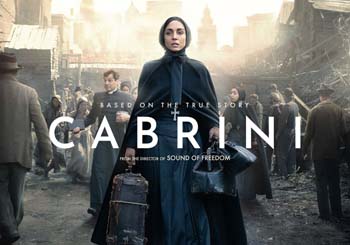
Two Mother Cabrinis - the real Saint & the film's feminist
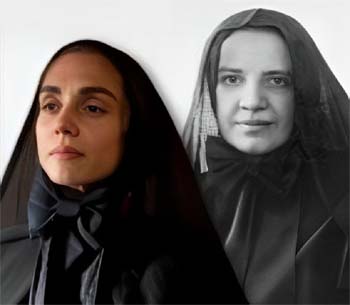
Though some have hailed director Alejandro Monteverde for representing a Saint, this movie is worse than no representation at all, for it provides viewers with a warped first impression of Mother Cabrini. It would not be an exaggeration to say it creates an "anti Cabrini" to overshadow the real Saint. Instead of the heroic and blameless Mother Cabrini, we are presented with a feminist and humanist revolutionary.
The picture at right, which compares the real Mother Cabrini with the movie's version of her, tells all that we need to know. Aside from the habit which both women wear, the two look almost nothing alike.
The true Mother Cabrini exudes seriousness, tranquility and sweetness, even amid great hardships and sufferings. Her gaze is steady and strong, but seems to be contemplating things of Heaven even while she resolves the thousand practical problems that she faced with the 67 institutions she founded. The mouth is broad, full but very firm, reflecting the Italian amiability and ease of speech with which she was aptly gifted.
By nature, she was unassertive, retiring and even timid. It was because of her confidence in God that she would plunge forward and undertake seemingly impossible works. The iron will that conquered herself and the world shows clearly on her almost glowing face, which reflects candor, courage and compassion. We know we are before a remarkable and holy woman.
In stark contrast, the "Mother Cabrini" from the movie appears both rebellious and profoundly sad. She is the opposite of the real Saint. We can observe this revolutionary spirit in the proud way she holds up her head in the face of authority and the way she glares in defiance at them.

A self-absorbed defiant portrayal
Most of the general facts about the Saint's life in this two and a half hour film are loosely based in truth, but the film as a whole is overly dramatic and "sensational," like most films that attempt to portray a Saint’s life. Cabrini follows this trend and throughout the long saga it centers more on justice, sexism and immigration than on the Catholic missionary spirit that in reality inspired Mother Cabrini. Her burning zeal was to save souls. But in this film her driving goal is to improve the material world of Italian immigrant.
A fictitious scene & false portrayal
A pivotal scene early in the movie sets the tone. At first, we are greeted by a brief glimpse of pre-Vatican II sacrality. Pope Leo XIII (who looks nothing like the real Pope Leo), surrounded by an entourage of Cardinals, Bishops and members of the Swiss Guard, processes through a magnificent hallway. The scene then cuts ahead a few minutes, when Mother Cabrini enters the room where they have gathered. Her presence immediately feels like a challenge to this order; it is implied that she is the "fresh air" to clear out the "stuffiness" of the Church.

A scene that takes place only in the film, not in the real life of Mother Cabrini
This is an invented line, put into the mouth of this "man in power" to show how religious women were treated as inferiors. Soon afterward, we see Mother Cabrini stomping through the halls like a revolted teenager, most unfitting of a religious and far from ladylike. She yells in a loud voice at the Cardinal, unmindful of the humility or obedience required of a true religious.
Mother Cabrini then demands to speak directly with the Pope, and after he also refuses her request, she asks him: "Is it because I am a woman? Is that why I must limit my scope?" This is certainly not something Mother Cabrini said or even would say; none of her biographies report such a retort.
Again, an exaggerated emphasis is put on the false idea that all the problems Mother Cabrini faced were due to her being a woman in a world run by men.
In fact, what really happened on Mother Cabrini's visit to Rome is completely different. During a difficult period in her early foundations in Milan, she had a dream in which the Infant Jesus appeared to her and said: "Go to Rome." She acted on what she believed was a divine counsel. Therefore, rather than being "summoned" to Rome, she went freely, her first pilgrimage being to the altar of her patron St. Francis Xavier in the Chiesa di Gesù.
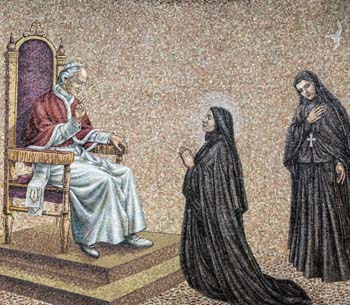
The fact: Mother Cabrini knelt before the Pope; below, in the film: she stands - egalitarianism

He received her kindly but felt her Order had still not developed sufficiently, so set a condition for permission to found a House in Rome: She must have half a million in lire as proof of sufficient capital for the purpose. Mother Cabrini and her accompanying sister humbly accepted his words, knelt to kiss his ring and left.
Later she would again request permission that the Cardinal to speak to the Pope about her Institute. Seeing her determination and goodness, he agreed kindly. Two weeks later, in her third interview with the Cardinal Vicar, he greeted her warmly. "Mother Cabrini. Are you prepared to obey?”
"Of course, Your Eminence," she replied.
"In that case I do not allow you to establish one House in Rome. Instead, I order you to found two Houses.” Which she proceeded to do.
When Mother Cabrini finally met Pope Leo XIII eight years later, the Cardinal had already presented the idea that this intrepid but humble nun should be sent to America to help the struggling Italians there. She was invited to the Vatican and conducted ceremoniously into a private audience; the Pope greeted her graciously and questioned her seriously about the Institute she had founded whose member already numbered 145, and then he blessed her.
Shortly afterwards, she was asked to accept the America mission, which she agreed to do only after serious prayer. (Theodore Maynard, Too Small a World, Milwaukee, 1945, Kindle edition,)
What a completely different story than the scene the Cabrini scriptwriters present! It is sad to say this same fabrication and re-invention of the real episodes of Mother Cabrini's life is what we find throughout the rest of the movie...
Presenting a social worker, not a Saint
In addition to the movie's feminist message, there is also a still more insidious progressivist one. The film would have us believe that Mother Cabrini's primary purpose was to provide the Italian immigrants with material assistance. Although scenes abound of her feeding the poor, providing shelter to homeless children, and caring for the sick, Mother Cabrini rarely speaks to anyone about God.
Her irreverence is notable, possible only in a post Vatican II nun: e.g.:
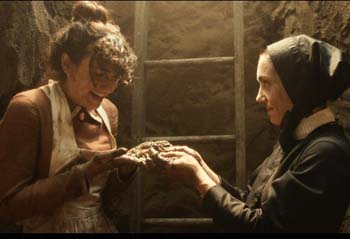
The film presents a prostitute as a fellow social worker, not as a repentant sinner
- She prays only once during the film (before a meal);
- She walks in churches and has conversations (even with the Bishop) without any sense of reverence for the Blessed Sacrament present there;
- She converts a prostitute, Vittoria, to the Catholic Faith, but presents her as a victim, telling her: "We are both survivors." Gone is the notion of making penance for her sins. Is this the way a Saint would act?
- There is no reference to her strong and fervent devotion to Our Lady, her Model and Mistress.
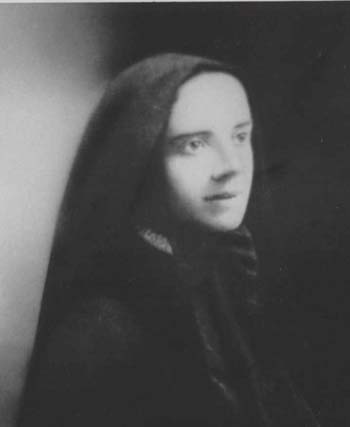
The real Mother Cabrini had a transcendent & supernatural view of the world
The Saint was famous for seeking the divine in all things. During her many sea voyages to found new Houses, she would find in it an image of some aspect of supernatural realities.
When the sea was calm, she saw in it the serenity of a soul that lives in the tranquility of the grace of God. "God commands," she wrote, "the sea obeys. If also in religion every Sister would obey her superior with perfect submission, without relying on her own judgment, what peace, what paradisiac sweetness would be hers." (Ibid., p. 154)
Does this sound like the impudent and headstrong Cabrini presented in the film?
Conclusion
We should make reparation to God and His Holy Mother for the disrespect and blasphemies of these modern-day movies. It should make us sorrowful to see such mockeries and lies about the holy lives of souls who worked with all their strength for the glory of God.
Let us look to good books if we wish to acquaint ourselves with the Saints, rather than to these revolutionary renditions that the cinema industry continues to give us. May Mother Cabrini pray for us and assist us from Heaven to not swallow the feminist lies with which the Revolution wishes to trick us.

Posted June 14, 2024
______________________
______________________





